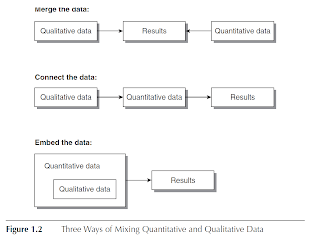Dear New Investigators,
During the last ISOQoL conference we learned about applications of
“mixed methods” approach in HRQoL research and I heard that it was of interest to new investigators. So, Antonia and I thought it might be
good to open a discussion about it on our blog. We are not experts, but we reviewed some sources and want to share some introductory information (text taken from references listed in the end).
You are more than welcome to post comments, questions or share
your experiences!
Best,
Katerina
What is “mixed
methods research”?
·
Mixed methods research involves both
collecting and analyzing quantitative and qualitative data and mixing data. It
is not enough to simply collect and analyze quantitative and qualitative data;
they need to be “mixed” in some way, so that together they form a more complete
picture of the problem than they do when standing alone.
·
This approach addresses restrictions
associated with quantitative data (e.g. excluding voices of participants) and
qualitative data (e.g. personal interpretations).
·
Critical issues in this approach are the extensive
time and resources and sampling issues (across
databases)
·
There are different ways data can be combined.
Merging
data. This integration consists of combining the qualitative data in
the form of texts or images with the quantitative data in the form of numeric
information. This integration can be achieved by reporting results together in
a discussion section of a study, such as reporting first the quantitative
statistical results followed by qualitative quotes or themes that support or
refute the quantitative results. It also can be achieved by transforming one data set (e.g., counting the occurrence of themes in a qualitative data set) so
that the transformed qualitative results can be compared with the quantitative
data set. This integration also can occur through the use of tables or figures
that display both the quantitative and the qualitative results (i.e., data
displays).
Connecting
data. This integration involves analyzing one data set (e.g., a
quantitative survey), and then using the information to inform the subsequent
data collection (e.g., interview questions, identification of participants to
interview). In this way the integration occurs by connecting the analysis of
results of the initial phase with the data collection of the second phase of
research.
Embedding
data. In this form of integration, a data set of secondary priority is
embedded within a larger, primary design. An example is the collection of
supplemental qualitative data about how participants are experiencing an
intervention during an experimental trial. Alternatively, a qualitative data
collection may precede an experimental trial to inform development of procedures
or follow an experimental trial to help explain the results of the trial.
Application
in Quality of Life Research
Applies to instrument development,
theoretical model development, utilities, methodological validation, clinical
use of quality-of-life measures, and understanding treatment outcomes.
The use of mixed methods is most
suitable when a quantitative or qualitative approach, by itself, is inadequate
to develop multiple perspectives and a complete understanding about a research
problem or question. As part of instrument development, these qualitative
methods are used to identify important and relevant concepts for measurement
and for generating item content to cover these concepts. In contrast,
quantitative research often focuses on sampling from a population and making
inferences about the population based on the information about the sample. For
example, research might seek to increase an understanding of patient responses
that result in barriers to using specific treatments or differences in
attitudes about research.
Further
reading
Book
Creswell JW, Plano Clark VL (2010)
Designing and Conducting Mixed Methods Research. Sage Publications
Articles
Schwartz CE, Revicki DA (2012) Mixing
methods and blending paradigms: some considerations for future research Qual
Life Res (2012) 21:375–376)
Klassen AC; Creswell J; Plano Clark VL; Clegg Smith K;
Meissner HI (2012) Best practices in mixed methods for quality of life research.
Qual Life Res, 21, 377-380
Example of
recent HRQoL study using mixed methods approach
Harley C, Takeuchi E, Taylor C, Keding A, Absolom K,
Brown J, Velikova G (2012) A mixed methods approach to adapting health-related
quality of life measures for use in routine oncology clinical practice Quality
of Life Research, 21:389–403
And, if
you are considering using this approach, take into account that using some kind
of software, such as QDA Miner, that can really help you!
Resources
text taken from:
Creswell
JW, Plano Clark VL (2010) Designing and Conducting Mixed Methods Research. Sage Publications
Schwartz
CE, Revicki DA (2012) Mixing methods and blending paradigms: some
considerations for future research Qual Life Res (2012) 21:375–376)
Klassen
AC; Creswell J; Plano Clark VL; Clegg
Smith K; Meissner HI (2012) Best practices in mixed methods for quality of life
research. Qual Life Res, 21, 377-380





